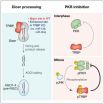(Press-News.org) COLUMBUS, Ohio - The serious air pollution problem in China has attracted the attention of online activists who want the government to take action, but their advocacy has had only limited success, a new study has revealed.
Instead, much of the online conversation has been co-opted by corporations wanting to sell masks, filters and other products and by government officials advancing its own environmental narrative, the study finds.
Researchers at The Ohio State University analyzed about 250,000 posts on the Chinese social media site Sina Weibo (similar to Twitter) that discussed the pollution problem in the country.
They concluded that online activists did force the Chinese government to take some actions to tackle the pollution problem. But they also found that business and government dominated much of the conversation and used it to their own advantage.
"Social media has been touted as a 'liberation technology' for citizens, but we found the story wasn't so straightforward in China," said Daniel Sui, co-author of the study and professor of geography at Ohio State.
"Along with the positive gains brought by social media, there were negatives."
Sui conducted the study with Samuel Kay and Bo Zhao, both graduate students at Ohio State at the time of the study. Their findings appear online (article available here) in the journal The Professional Geographer.
The researchers used a custom-built web-crawler, designed by Zhao and housed on servers at Ohio State's Center for Urban and Regional Analysis, to search for air pollution-related posts on Sina Weibo from October 2012 to June 2013.
They also traveled to China to interview citizens and collect media coverage, government reports, diplomatic communications and public statements made by officials.
Sui said he and his students saw first-hand the air pollution problem in the country.
"Last summer all three of us were in Beijing and one day the smog was so bad that you literally couldn't see the building across the street," he said.
For decades, the Chinese government blamed hazy days on fog or dust. Government reports completely ignored certain pollutants, such as PM2.5, which is airborne particulate 2.5 micrometers or less in diameter. Because of its small size, PM2.5 can penetrate deep into the cardiovascular and respiratory systems.
But when the U.S. Embassy in Beijing began publishing air quality data on its official Twitter feed in 2008, local citizens began to take notice, Sui said.
Chinese citizens began posting about the issue on Sina Weibo, wondering why there wasn't official information on PM2.5 and asking for action by the Chinese government.
This online activism did have an impact, Sui said. Eventually, the Chinese central government acknowledged the air pollution problem, setting new air pollution guidelines and introducing new enforcement mechanisms.
"Social media raised public awareness and pressured the government to take some action. It had enormous power that way. Otherwise, the government wouldn't have done as much as they have," Sui said.
But the improvements in pollution have been relatively modest, and the researchers found that companies, the government and a few opinion leaders have been able to largely shape the online discussion along narrow and often profitable lines.
Sui and his students found that just one-tenth of 1 percent of the users of Sina Weibo in this discussion held more than 60 percent of what is called the "weighted-in degree," which is a measure of user influence. More than 80 percent of these top accounts belonged to government sources, companies or other organizations, while only 20 percent belonged to individuals.
"The most influential users in the debate were almost entirely composed of government sources, companies or famous individuals," Sui said.
Corporations used Sina Weibo to push products specifically designed to appeal to anxious citizens. One company advertised an air filtration system on Sina Weibo, saying that it was "using the most advanced technology for the filtration of PM2.5" and will enable customers to "breathe healthier air."
The attitude of corporations on social media was that Chinese citizens could simply avoid the air pollution problem - if they could afford to buy these specialized products.
Sui said the Chinese government response on Sina Weibo was to attempt to "make air pollution a scientific rather than a political problem."
The government tried to give the impression that the air pollution problem could be solved mostly through technological fixes without hurting economic growth.
Sui said this case study shows both the power and the limits of online activism in China.
"Citizens acting online made some real changes to how the government handled the air pollution problem, but government and corporations used the same online tools to advance their own agendas as well," he said.
INFORMATION:
The study was funded by a grant from the National Science Foundation.
Contact: Daniel Sui, (614) 688-5441; Sui.10@osu.edu
Written by Jeff Grabmeier, (614) 292-8457; Grabmeier.1@osu.edu
Technology has changed rapidly over the last few years with touch feedback, known as haptics, being used in entertainment, rehabilitation and even surgical training. New research, using ultrasound, has developed an invisible 3D haptic shape that can be seen and felt.
The research paper, published in the current issue of ACM Transactions on Graphics and which will be presented at this week's SIGGRAPH Asia 2014 conference [3-6 December], demonstrates how a method has been created to produce 3D shapes that can be felt in mid-air.
The research, led by Dr Ben Long and ...
Parents and family make all the difference in creating the next generation of scientists, engineers and mathematicians, according to new research by George Mason University.
"We were surprised to learn that the family is more important than we ever thought in terms of igniting the passion of future scientists," says Lance Liotta, a study author and co-director of George Mason's Center for Applied Proteomics and Molecular Medicine.
The study, featured in CBE-Life Sciences Education, is the first peer-reviewed article of its kind to focus on what initially attracts young ...
AMHERST, Mass. - Using a new approach for determining the age at sexual maturity for wild stocks of western Atlantic bluefin tuna, researchers led by Molly Lutcavage of the University of Massachusetts Amherst and Gilad Heinisch of Israel's Oceanographic and Limnological Research Center, suggest that these fish mature at a considerably younger age than cuurently assumed. These findings could lead to changes in how fisheries scientists estimate the population.
Lutcavage says, "Whether a bluefin tuna or cod, for realistic fish stock assessments it's important to know at ...
December 2, 2014 - Now you don't even have live in Estonia to open a business there. A new program lets people purchase e-signatures that enable them to open bank accounts and run a domestic business without being physically present. But according to new research, people may not have the same trust in such businesses as they would others. A new paper finds that people are much more likely to discount the validity of an e-signature than a hand-signed document.
"Although e-signatures provide greater efficiency and convenience, they just seem a bit inauthentic," says Eileen ...
LOS ANGELES (Dec. 1, 2014) - Research scientists have developed a novel method to re-create brain and intestinal stem cells from patients who died decades ago, using DNA from stored blood samples to study the potential causes of debilitating illnesses such as inflammatory bowel disease.
The lab research, published in the journal STEM CELLS Translational Medicine, could yield new therapies for people who suffer from aggressive motor-neuron and gut-related conditions that proved fatal to the deceased patients who long-ago volunteered their blood samples.
"The potential ...
Philadelphia, PA, December 1, 2014 - "Triple-negative" breast cancer (TNBC) occurs in patients whose cells do not express receptors for estrogen, progesterone, and/or human epidermal growth factor receptor 2 (ER/PR/HER2). Because of the absence of these predictive biomarkers, treatment assignment can be difficult. Now, researchers report that high levels of the microRNA miR-21 in the tumor microenvironment, but not in the tumor epithelia (cancer cells), are associated with worse clinical outcomes for patients with TNBC, thus identifying a possible ...
Research at the University of Adelaide has discovered cancer cells may be particularly susceptible to metabolic stress - opening the way for new targeted therapy that won't harm normal cells.
The researchers showed that chromosomal instability - which is a hallmark of rapidly dividing cancer cells - makes them stressed and vulnerable to mild metabolic disruption. Metabolism is the normal process by which the body turns food into energy.
"A common problem in treating cancers is that they don't respond to chemotherapy, or they respond for a while, but then come back," ...
The research team of the Center for RNA Research at IBS has succeeded in revealing that the dsRNAs and Protein Kinase R (PKR) regulate division of mammalian cells.
This finding will provide important clues to understanding the process of tumor formation and the mechanism for suppressing cancer since the abnormal cell division marks the early events of cancer development.
For the first time, the IBS research team has found that during mitosis, the cellular dsRNAs activate PKR, an enzyme previously known as a trigger of immune response during virus infection. Activated ...
Inflammatory skin diseases such as psoriasis may result from abnormal activation of cell death pathways previously believed to suppress inflammation, a surprise finding that could help to develop new ways of treating these diseases.
Mr James Rickard, Associate Professor John Silke and colleagues from the Walter and Eliza Hall Institute made the discovery while investigating how cell death pathways are linked to inflammatory disease development. The study was published today in the journal eLife.
Infected cells, cancerous cells, or those that are simply unnecessary to ...
Vitamin D deficiency is not just harmful to physical health--it also might impact mental health, according to a team of researchers that has found a link between seasonal affective disorder, or SAD, and a lack of sunlight.
"Rather than being one of many factors, vitamin D could have a regulative role in the development of SAD," said Alan Stewart of the University of Georgia College of Education.
An international research partnership between UGA, the University of Pittsburgh and the Queensland University of Technology in Australia reported the finding in the November ...



